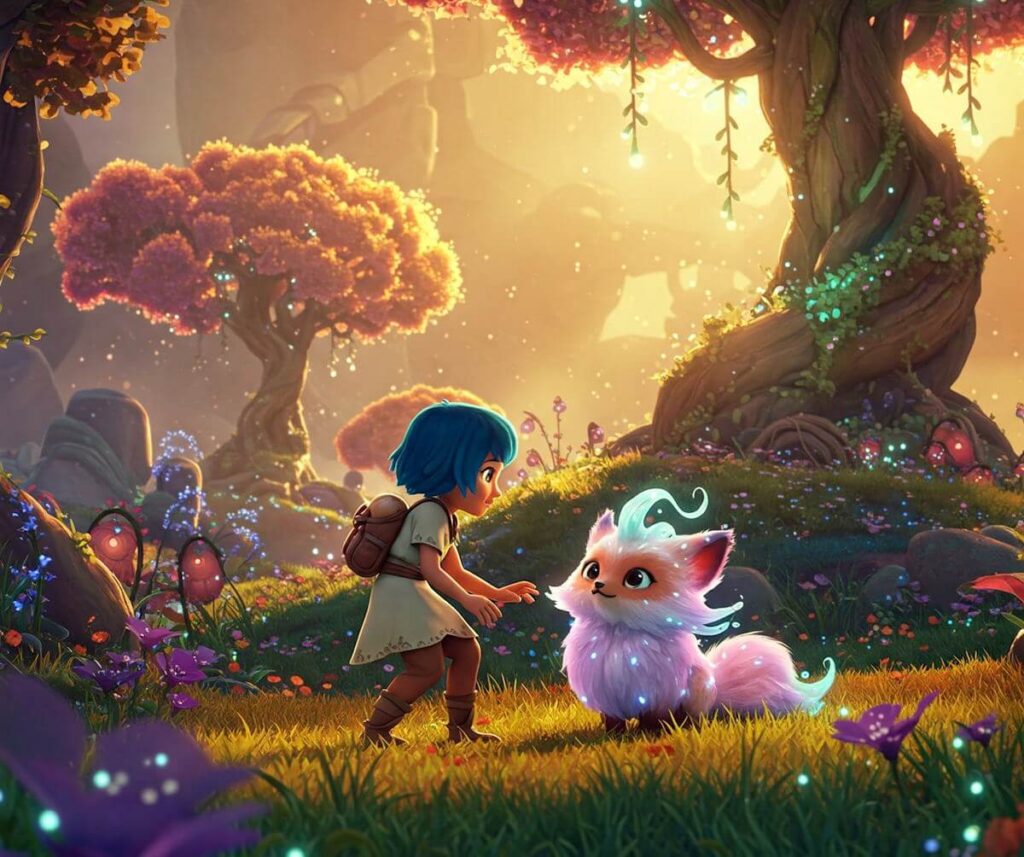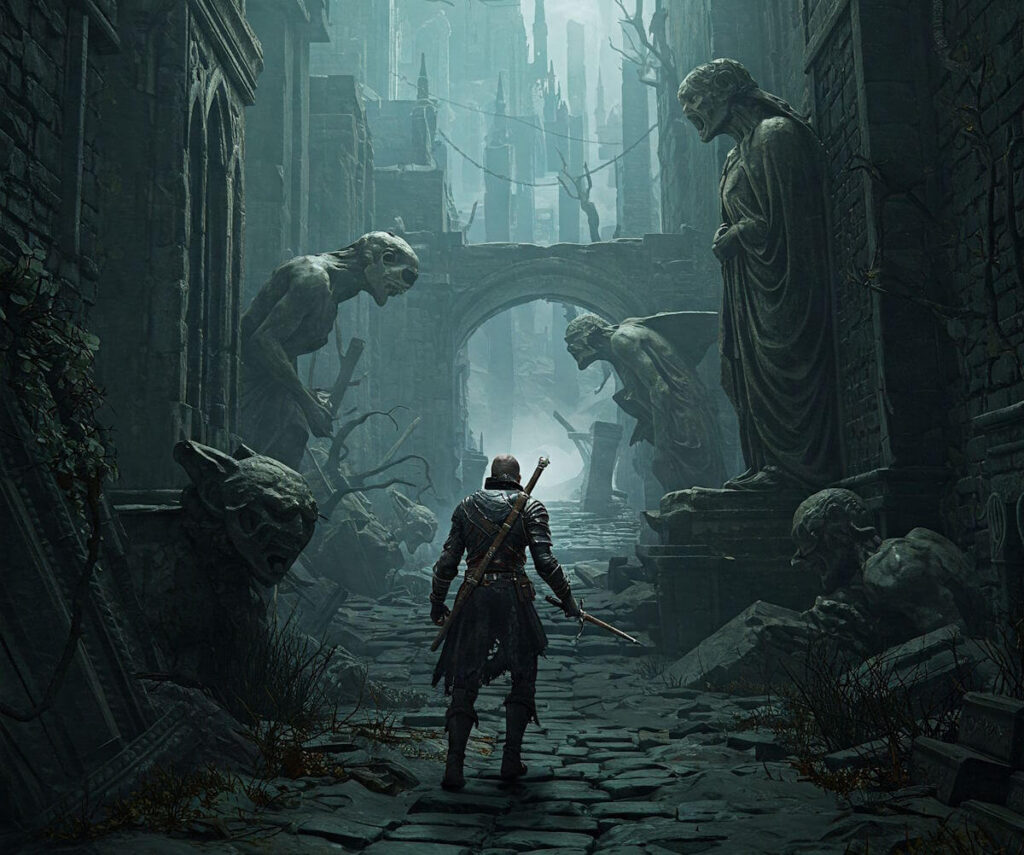Planet of Lana is an indie video game developed by Wishfully Studios that has garnered significant attention within the gaming community since its announcement. Set against a mesmerizing backdrop of hand-painted visuals and atmospheric soundscapes, the game immerses players in a beautifully crafted world that feels both enchanting and melancholic. The premise centers around the journey of a young girl named Lana and her loyal companion, Mui, as they traverse an extraordinary planet filled with peril and wonder. This narrative-driven experience places a strong emphasis on friendship and exploration, inviting players to engage deeply with its story.
The artistic direction of Planet of Lana is one of its most compelling features. The striking aesthetic is reminiscent of a beautifully illustrated storybook, offering a visual style that captivates players from the outset. Through detailed environments and colorful character designs, the game creates a sense of wonder that encourages exploration. Moreover, the developers have consciously chosen to minimize text and dialogue, allowing the visual storytelling to shine. This unique approach fosters an emotional connection with the characters, making every moment a poignant experience.
In terms of gameplay, Planet of Lana combines traditional platforming mechanics with innovative puzzle-solving elements. Players are encouraged not only to navigate through challenging environments but also to interact meaningfully with the world around them. The seamless blend of gameplay and narrative helps create a rich, immersive atmosphere that stands out in the indie gaming scene. Players can expect to engage both intellectually and emotionally, as the game weaves together themes of companionship, adventure, and the resilience of the human spirit. Overall, Planet of Lana promises a cinematic experience that appeals to a diverse audience, reinforcing the indie game’s capacity for storytelling and artistic expression.
Art and Visuals: A Feast for the Eyes
The captivating art style of ‘Planet of Lana’ stands as a testament to the power of hand-painted visuals in the realm of indie gaming. This vibrant aesthetic not only creates a visually stunning environment but also serves to immerse players in a world that feels both otherworldly and familiar. Each frame is meticulously crafted, presenting an intricate tapestry of colors and textures that invites exploration. The developers have harnessed a unique color palette, marked by rich blues, lush greens, and warm earth tones, which draws players into its lush landscapes. Such deliberate choices in visual presentation meld seamlessly with the narrative, enhancing emotional connection and engagement.
Moreover, the contrast between foreground and background elements further enriches the player’s experience, allowing for dynamic interactions within this beautifully illustrated habitat. The delicate animations of both character movements and environmental elements breathe life into the world, making even the simplest actions appear fluid and expressive. This attention to detail elevates ‘Planet of Lana’ above its contemporaries, positioning it as an artistic achievement in the indie game scene.
Comparing ‘Planet of Lana’ to other visually impressive games, such as ‘Journey’ or ‘Ori and the Blind Forest,’ it becomes clear that while each title boasts unique aesthetics, ‘Planet of Lana’ carves out its identity through its enchanting color schemes and hand-drawn artistry. The visual narrative is further complemented by a bespoke soundtrack, which harmonizes perfectly with the visual elements to enrich the player’s journey. This holistic approach to game design underscores how art and visuals serve not merely as eye candy but as a vital component that amalgamates gameplay, story, and player emotion. As such, ‘Planet of Lana’ stands out as a dazzling feat, celebrating the marriage of art and gaming in the indie landscape.
Gameplay Mechanics: A Unique Experience
In the realm of indie gaming, “Planet of Lana” stands out due to its innovative gameplay mechanics that seamlessly blend puzzle-solving elements with engaging platforming challenges. The game invites players to navigate a beautifully crafted environment, rich in artistic detail, while utilizing their problem-solving skills to progress through various levels. Each challenge is designed to test the player’s creativity and resourcefulness, making every obstacle feel both rewarding and enriching.
The puzzle-solving mechanics in “Planet of Lana” are intricate yet accessible, allowing players of all skill levels to engage with the game on different levels. These challenges often require critical thinking and exploration, encouraging players to interact with the environment in a meaningful way. The carefully designed puzzles not only serve as a means to advance the storyline but also enhance the overall gaming experience, as players grow emotionally connected to the character and the unfolding narrative.
A significant aspect of “Planet of Lana” is its cooperative gameplay with Lana’s companion. This character plays a crucial role in solving puzzles and overcoming obstacles. The interaction between Lana and her companion encompasses a variety of mechanics, such as teamwork and strategic planning, thereby reinforcing the game’s themes of companionship and collaboration. This cooperative dynamic offers players an opportunity to experiment with different strategies to tackle challenges, further enhancing immersion and engagement with the story.
The carefully crafted gameplay mechanics of “Planet of Lana” not only challenge players intellectually but also evoke a sense of emotional investment in the characters and their journey. The blend of puzzles and platforming, coupled with cooperative gameplay, creates a unique experience that captures the essence of indie gaming, making “Planet of Lana” a title that is both artistically and mechanically enriching.
Narrative and Themes: Deep Emotional Resonance
‘Planet of Lana’ presents a rich narrative that resonates deeply with players through its exploration of themes such as friendship, adventure, and environmental consciousness. The story unfolds in a beautifully crafted world that invites players to embark on a journey alongside Lana, a young girl navigating through an expansive landscape filled with wonders and dangers. As players progress, they are introduced to a mystical creature named Mui, who becomes not only a companion but also a pivotal part of Lana’s journey. The bond between Lana and Mui exemplifies the theme of friendship, showing how mutual support and trust can help individuals overcome the challenges presented by a daunting environment.
Exploration is another significant theme in ‘Planet of Lana’. The game encourages players to immerse themselves in its vibrant world, filled with diverse ecosystems that emphasize the importance of nature. Through Lana’s quest, players encounter various landscapes that showcase the breathtaking beauty and fragility of the environment. This not only serves as a backdrop for the narrative, but also subtly communicates a message about environmental awareness and the need to protect natural habitats. The interplay between exploration and environmental themes enriches the gameplay experience, fostering a sense of connection with the world and its inhabitants.
Moreover, the narrative is intricately woven into the gameplay and visual storytelling elements. The animations are meticulously crafted to convey emotions and reactions, adding layers to the story as players engage with various puzzles and challenges. As players solve problems and move through the environment, they witness how Lana’s courage and determination fluctuate, reinforcing the overarching narrative. The harmonious blend of narrative, gameplay mechanics, and visual artistry ensures that ‘Planet of Lana’ leaves a lasting impact, inviting players to reflect on the emotional stakes tied to friendship, exploration, and environmental stewardship. The depth of the story is a testament to the potential of indie games to evoke profound emotional responses.
Sound Design: The Soundtrack that Envelops You
Sound design plays an essential role in the overall experience of any video game, and in ‘Planet of Lana’, the original score is particularly noteworthy. The musical composition brilliantly captures the emotional landscape of the game, immersing players in its enchanting world. Composed with great care, the soundtrack is not only harmonious but also intricately woven into the gameplay, responding dynamically to the player’s actions. This approach elevates the ambient experience, creating a sense of connection between the player and the environment.
The emotional impact of the soundtrack is significant, as it guides players through the various narratives and themes interspersed throughout the game. Each musical piece is thoughtfully crafted to evoke specific feelings, whether it be the tranquility of exploration or the tension during moments of uncertainty. The score enhances moments of solitude, encouraging players to reflect on their journey, while also amplifying the intensity of more dramatic encounters. The emotional resonance generated by the music helps to build a deep sense of attachment to the characters and their quests.
In addition to the melodic score, the sound effects in ‘Planet of Lana’ further enhance immersion. Every sound, from the subtle rustling of leaves to the stirring of creatures, contributes to a rich auditory tapestry that envelops players. These carefully designed audio elements not only support the visual aesthetics but also provide essential cues that guide players throughout their adventure. By seamlessly integrating sound design within the game’s mechanics, ‘Planet of Lana’ excels in creating a vivid and engaging atmosphere.
Ultimately, the combination of emotional music and immersive sound effects ensures that ‘Planet of Lana’ delivers a captivating cinematic experience, inviting players to lose themselves in its beautifully crafted world.
Comparisons with Other Indie Titles
‘Planet of Lana’ emerges as a distinctive figure in the indie gaming landscape, drawing inevitable comparisons with other acclaimed titles such as ‘Limbo’ and ‘Spiritfarer.’ Both of these games are beloved for their artistic presentations and poignant themes, yet they diverge significantly in gameplay mechanics and narrative approach, thereby offering a unique perspective on what the indie genre can offer.
On the other hand, ‘Spiritfarer’ explores the themes of death and the afterlife, focusing on relationships and emotional connection through its narrative-driven gameplay. Unlike ‘Spiritfarer’, ‘Planet of Lana’ keeps its story relatively straightforward but nonetheless engaging, revolving around companionship and adventure. While both games implement a strong emphasis on exploration, ‘Planet of Lana’ immerses players in a more whimsical journey characterized by vivid environments and enchanting soundscapes, creating an immersive experience that aligns closely with exploration and discovery.
Ultimately, comparing these indie titles provides a clearer understanding of ‘Planet of Lana’s’ positioning within the genre. Its unique artistic vision, coupled with innovative gameplay mechanics, distinctly separates it from titles like ‘Limbo’ and ‘Spiritfarer’, making it a noteworthy addition to the indie gaming community.
Critics and Player Reception
The reception of ‘Planet of Lana’ has been notably positive, resonating with both game critics and players alike. Upon its release, many notable gaming publications praised the game for its breathtaking visual artistry and engaging narrative. Critics have highlighted the hand-painted art style, which provides a visceral experience, transporting players into a lush, vibrant world that feels both immersive and alive. The game’s music has also garnered accolades for its ability to complement the emotional journey of the story, enhancing the overall atmosphere.
Moreover, the core mechanics of ‘Planet of Lana’ received commendations for their intuitive design. The gameplay seamlessly combines elements of adventure and puzzle-solving, making players feel a sense of accomplishment as they progress. Such positive feedback indicates that developers have successfully crafted a user-friendly experience that caters to a wide audience, from seasoned gamers to those new to the genre.
However, despite the overwhelmingly affirmative critiques, there have been some mentions of shortcomings. A few players expressed a desire for more depth in character development, pointing out that while the visuals were stunning, the emotional connections could have been further explored. Some critics mentioned that the pacing of the gameplay felt slightly uneven at times, potentially detracting from the overall engagement.
In the broader context of indie games, ‘Planet of Lana’ stands out as a commendable effort, largely due to its artistic vision and innovative gameplay mechanics. Players appear to appreciate this dedication to artistic excellence and emotional storytelling, creating an enriched experience that distinguishes it within the indie gaming landscape. The game’s reception thus reflects a growing appreciation for titles that prioritize creativity and artistic expression, making ‘Planet of Lana’ a noteworthy addition to the genre.
Looking Ahead: Future of Planet of Lana
The independent gaming landscape is continually evolving, and as a notable addition, Planet of Lana stands out for its unique aesthetic and engaging gameplay. Considering its recent launch, players are curious about the potential for updates or expansions that could further enrich their gaming experience. Developers frequently utilize player feedback post-release to make necessary adjustments, ensuring that they meet community expectations. Such an approach not only enhances the game but also fosters a deeper connection with its audience.
As with many indie titles, the success of Planet of Lana can pave the way for future content. Developers might consider introducing new storylines, additional gameplay mechanics, or even seasonal events. Expansions could delve deeper into the lore of the game, enriching players’ understanding of its world while maintaining the charm that initially captivated them. Additionally, a strong community engagement strategy can ensure that players remain invested in the game over time. The inclusion of user-generated content or community challenges could serve to foster collaboration among players, enhancing the game’s longevity.
Moreover, the impact of Planet of Lana on the indie game landscape cannot be understated. It showcases the potential for innovative storytelling and visual design within this sector, serving as a blueprint for budding developers. As Planet of Lana attracts attention, it may inspire a wave of upcoming titles that mirror its artistic vision and gameplay style. This ripple effect could lead to a renaissance of creativity in indie gaming, pushing boundaries and encouraging fresh ideas. Therefore, players can remain hopeful that the future of Planet of Lana not only promises exciting developments but also contributes to a flourishing community where story-driven titles can thrive.
Conclusion: Why You Should Explore Planet of Lana
In considering the charm and appeal of Planet of Lana, it is important to recognize the game’s captivating narrative and stunning visual artistry. This indie title stands out not only for its unique story but also for the emotional depth it provides to players. Through the eyes of Lana, players experience a journey that is rich in friendship, cooperation, and environmental themes, all set in a beautifully crafted world. The game seamlessly blends these elements, inviting players to engage deeply with its storyline while exploring striking landscapes.
Additionally, Planet of Lana excels in providing an immersive atmosphere that is both enchanting and thought-provoking. Its artistic direction draws from cinematic influences, creating a visual feast that captivates players from the very beginning. The sound design plays a pivotal role too, enhancing the overall experience and enveloping players in a serene yet poignant environment. This well-executed combination of visuals and sound elevates the gameplay, making it a memorable experience.
Furthermore, the mechanics of cooperation with the creature, Mui, serve not only as a gameplay feature but also as a metaphor for teamwork and understanding in a broader context. This encourages players to think critically about their surroundings and the relationships they foster within them. Such themes resonate well within the indie gaming sphere, showcasing how small studios can deliver narratives that prompt reflection and discussion.
In light of these aspects, Planet of Lana warrants exploration for both avid gamers and newcomers to the indie genre. By experiencing this game, players not only enjoy a remarkable adventure but also support the continued evolution of indie games, which often push boundaries in storytelling and artistic expression. Engaging with this title is not just about playing; it is about connecting with an artistic masterpiece that influences the future of gaming.





